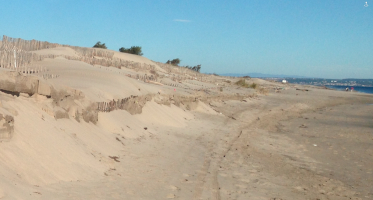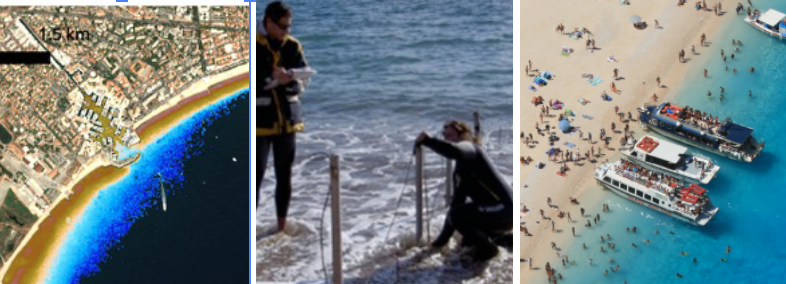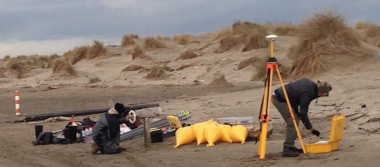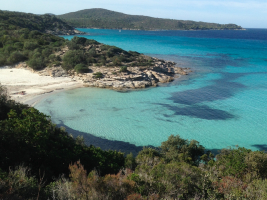
This unit will dwell on technically addressing the main geomorphic, hydrodynamic and sediment flux problems that determine coastal stability, erosion, and subsidence, and the means and techniques deployed to counter instability – from the heavy engineering approach through ‘softer’ methods (renourishment, sand engine …), and, increasingly, ‘nature-based solutions’. The spheres of application, limits, stakes, costs, efficiency, praticability, and impacts on coasts and on sediment connectivity are analysed with a critical consideration of their sustainability in the face of increasing storminess and sea-level rise.
Keywords: nature-based solutions, coastal defence, coastal protection, coastal engineering, sustainability.
Keywords: nature-based solutions, coastal defence, coastal protection, coastal engineering, sustainability.
- Teacher: Edward ANTHONY
- Teacher: Francois SABATIER

- Teacher: Edward ANTHONY
- Teacher: Anne CADORET
- Teacher: Carine FOURNIER
- Teacher: Christophe MORHANGE
- Teacher: Samuel ROBERT
- Teacher: Francois SABATIER

This course focuses on public policies for coastal areas, documents and the diversity of stakeholders involved in the management of coastal areas, by addressing and questioning the concept and tools of Integrated Coastal Zone Management (ICZM). How are they designed and evaluated, and who manages them?
Wednesdays from 9 to 12am.
T. 1-3-09
October 9 : Meeting in Marseille with associations and public bodies involved in coastal management (9h Marseille = 14 quai Rive Neuve • 13007 Marseille)
November 8: Foresight day (compulsory): seminar and participatory workshop with Institut Somum and Plan Bleu as part of the Amidex Proteus project.
- Master the principles and challenges of integrated coastal management
- Ability to analyse the challenges of international cooperation in coastal zone management
- Ability to analyse the roles and missions of the players involved in coastal management and their networks (France, Mediterranean)
- Ability to present the main objectives of coastal and maritime planning in France
assessment methods: continuous assessment (3 marks).
mark 1: 30%
mark 2: oral = 30%
mark 3 : report : 40%
(december 18, 2024: oral presentation)
Andrew Merrie, C.Dunn Daniel, Marc Metian, Andre M. Boustany, Yoshinobu Takei, Alex Oude Elferink, Yoshitaka Ota, Villy Christensen, Patrick N. Halpin, Henrik Österblom, 2014, An ocean of surprises – trends in human use, unexpected dynamics and governance challenges in areas beyond national jurisdiction Glob. Environ. Change, 27 (2014), pp. 19-31, 10.1016/j.gloenvcha.2014.04.012
Ritschard, Lucille. (2020). Pour une valorisation des savoirs d’usage face aux risques côtiers dans un contexte de changement climatique. Application au territoire du Parc Naturel Régional d’Armorique (Finistère, France). Norois. ()257. p.55 - 69. 10.4000/norois.10564
Bailly, Guillaume, Bénédicte Rulleau, et Hélène Rey-Valette. "Apport des consentements à payer et de leur spatialisation à l'étude de l'acceptabilité des politiques d'adaptation à la montée du niveau de la mer liée au changement climatique", Géographie, économie, société, vol. vol. 18, no. 3, 2016, pp. 387-408.
Billé R., "Gestion intégrée des zones côtières : quatre illusions bien ancrées", VertigO - la revue électronique en sciences de l'environnement (En ligne), Volume 7 Numéro3 décembre 200
Drobenko B. « De la gestion intégrée des zones côtières (GIZC) a la politique maritime intégrée (PMI) : un nouveau droit pour le littoral ? », Revue juridique de l’environnement, vol. spécial, no. 5, 2012, pp. 225-246.
Hellequin, Anne-peggy, et al. « Perceptions du risque de submersion marine par la population du littoral languedocien : contribution à l'analyse de la vulnérabilité côtière », Natures Sciences Sociétés, vol. vol. 21, no. 4, 2013, pp. 385-399.
Henocque Y., « Leçons et futur de la gestion intégrée des zones côtières dans le monde », VertigO - la revue électronique en sciences de l'environnement [En ligne], Volume 7 Numéro 3 | décembre 2006
Wednesdays from 9 to 12am.
T. 1-3-09
October 9 : Meeting in Marseille with associations and public bodies involved in coastal management (9h Marseille = 14 quai Rive Neuve • 13007 Marseille)
November 8: Foresight day (compulsory): seminar and participatory workshop with Institut Somum and Plan Bleu as part of the Amidex Proteus project.
- Master the principles and challenges of integrated coastal management
- Ability to analyse the challenges of international cooperation in coastal zone management
- Ability to analyse the roles and missions of the players involved in coastal management and their networks (France, Mediterranean)
- Ability to present the main objectives of coastal and maritime planning in France
assessment methods: continuous assessment (3 marks).
mark 1: 30%
mark 2: oral = 30%
mark 3 : report : 40%
(december 18, 2024: oral presentation)
Andrew Merrie, C.Dunn Daniel, Marc Metian, Andre M. Boustany, Yoshinobu Takei, Alex Oude Elferink, Yoshitaka Ota, Villy Christensen, Patrick N. Halpin, Henrik Österblom, 2014, An ocean of surprises – trends in human use, unexpected dynamics and governance challenges in areas beyond national jurisdiction Glob. Environ. Change, 27 (2014), pp. 19-31, 10.1016/j.gloenvcha.2014.04.012
Ritschard, Lucille. (2020). Pour une valorisation des savoirs d’usage face aux risques côtiers dans un contexte de changement climatique. Application au territoire du Parc Naturel Régional d’Armorique (Finistère, France). Norois. ()257. p.55 - 69. 10.4000/norois.10564
Bailly, Guillaume, Bénédicte Rulleau, et Hélène Rey-Valette. "Apport des consentements à payer et de leur spatialisation à l'étude de l'acceptabilité des politiques d'adaptation à la montée du niveau de la mer liée au changement climatique", Géographie, économie, société, vol. vol. 18, no. 3, 2016, pp. 387-408.
Billé R., "Gestion intégrée des zones côtières : quatre illusions bien ancrées", VertigO - la revue électronique en sciences de l'environnement (En ligne), Volume 7 Numéro3 décembre 200
Drobenko B. « De la gestion intégrée des zones côtières (GIZC) a la politique maritime intégrée (PMI) : un nouveau droit pour le littoral ? », Revue juridique de l’environnement, vol. spécial, no. 5, 2012, pp. 225-246.
Hellequin, Anne-peggy, et al. « Perceptions du risque de submersion marine par la population du littoral languedocien : contribution à l'analyse de la vulnérabilité côtière », Natures Sciences Sociétés, vol. vol. 21, no. 4, 2013, pp. 385-399.
Henocque Y., « Leçons et futur de la gestion intégrée des zones côtières dans le monde », VertigO - la revue électronique en sciences de l'environnement [En ligne], Volume 7 Numéro 3 | décembre 2006
- Teacher: Anne CADORET

This unit is devoted to modelling, first conceptual, and then numerical, with emphasis on the latter, as well their virtues, advantages, and bottlenecks, as applied to coastal morphdynamics and prediction of future evolution. Various existing numerical models (Delft-3D, Mike 21 …) and asociated modules (waves, currents, sediment transport) will be analysed with examples on beaches, wave-influenced deltas, and tidal environments, together with the limits and potentiel of numerical simulation in predicting coastal mobility in response to sea-level rise.
Keywords: numerical modelling, conceptual modelling, forecasting, prediction, sea-level rise.
Keywords: numerical modelling, conceptual modelling, forecasting, prediction, sea-level rise.
- Teacher: Edward ANTHONY
- Teacher: Francois SABATIER
- Teacher: Florin ZAINESCU

Tuesdays from 1 to 5 p.m.
B. 105, EGGER
November 8: Foresight day : seminar and participatory workshop with Institut Somum and Plan Bleu as part of the Amidex Proteus project.
This course examines the principles, history and injunctions of public policies to set up Marine Protected Areas (MPAs), the diversity of governance methods for conserving coastal and maritime biodiversity, actions to manage fishing or recreational activities (e.g. light anchorage areas for boats), and the questioned effectiveness of MPAs.
-Understanding the diversity of MPA governance methods
-Identify the strengths and weaknesses of MPAs
-Be critical of coastal and ocean conservation policies
-Understand the role of indigenous peoples in MPA management
General theoretical input on the geography of coastal and ocean conservation and learning through case studies : TD, workshop, field trip
assessment methods: continuous assessment (3 marks).
mark 1: 30%
mark 2: oral = 30%
mark 3 : report : 40%
(december 17, 2024: oral presentation)
Zorondo-Rodríguez F., Díaz M., Simonetti-Grez G., Simonetti J.-A., 2019, « Why would new protected areas be accepted or rejected by the public?: Lessons from an ex-ante evaluation of the new Patagonia Park Network in Chile », Land Use Policy, 89, p. 104248. https://doi.org/10.1016/j.landusepol.2019.104248.
Beuret et Cadoret, 2024, Aires Marines Protégées : vaines promesses et vraies enjeux, PUR, 380p.
Laslaz L., Cadoret A., Milian J., 2020, Atlas des espaces protégés en France : des territoires en partage ? Museum National d’Histoire Naturelle.
McGinlay J., Jones N., Malesios C., Dimitrakopoulos P.-G, BegleyA., Berzborn S., Botsch K., et al. 2023, « Exploring local public support for protected areas: What social factors influence stated and active support among local people? » Environmental Science & Policy 145, 250 61. https://doi.org/10.1016/j.envsci.2023.04.003.
Maxwell S. L., Cazalis V., Dudley N., Hoffmann M., Rodrigues A. S. L., Stolton S., Visconti P., Woodley S., Maron M., Strassburg B. B. N., Wenger A., Jonas H. D., Venter O., Watson J. E. M., 2020, « Area-Based Conservation in the 21st Century », Preprints 2020, https://doi.org/10.20944/preprints202001.0104.v1
B. 105, EGGER
November 8: Foresight day : seminar and participatory workshop with Institut Somum and Plan Bleu as part of the Amidex Proteus project.
This course examines the principles, history and injunctions of public policies to set up Marine Protected Areas (MPAs), the diversity of governance methods for conserving coastal and maritime biodiversity, actions to manage fishing or recreational activities (e.g. light anchorage areas for boats), and the questioned effectiveness of MPAs.
-Understanding the diversity of MPA governance methods
-Identify the strengths and weaknesses of MPAs
-Be critical of coastal and ocean conservation policies
-Understand the role of indigenous peoples in MPA management
General theoretical input on the geography of coastal and ocean conservation and learning through case studies : TD, workshop, field trip
assessment methods: continuous assessment (3 marks).
mark 1: 30%
mark 2: oral = 30%
mark 3 : report : 40%
(december 17, 2024: oral presentation)
Zorondo-Rodríguez F., Díaz M., Simonetti-Grez G., Simonetti J.-A., 2019, « Why would new protected areas be accepted or rejected by the public?: Lessons from an ex-ante evaluation of the new Patagonia Park Network in Chile », Land Use Policy, 89, p. 104248. https://doi.org/10.1016/j.landusepol.2019.104248.
Beuret et Cadoret, 2024, Aires Marines Protégées : vaines promesses et vraies enjeux, PUR, 380p.
Laslaz L., Cadoret A., Milian J., 2020, Atlas des espaces protégés en France : des territoires en partage ? Museum National d’Histoire Naturelle.
McGinlay J., Jones N., Malesios C., Dimitrakopoulos P.-G, BegleyA., Berzborn S., Botsch K., et al. 2023, « Exploring local public support for protected areas: What social factors influence stated and active support among local people? » Environmental Science & Policy 145, 250 61. https://doi.org/10.1016/j.envsci.2023.04.003.
Maxwell S. L., Cazalis V., Dudley N., Hoffmann M., Rodrigues A. S. L., Stolton S., Visconti P., Woodley S., Maron M., Strassburg B. B. N., Wenger A., Jonas H. D., Venter O., Watson J. E. M., 2020, « Area-Based Conservation in the 21st Century », Preprints 2020, https://doi.org/10.20944/preprints202001.0104.v1
- Teacher: Anne CADORET

Course unit on methods and techniques in coastal geomorphology: field experiments, involving hydrodynamic and high-resolution topographic measurements and modelling, sediment dynamics, laboratory analytical techniques, remote sensing (drone, LiDar, satellite images, digital elevation models, sediment budgets), coupling with numerical modelling.
Keywords: field experiments, remote sensing, sediment budget dynamics, modelling
Keywords: field experiments, remote sensing, sediment budget dynamics, modelling
- Teacher: Edward ANTHONY
- Teacher: Helene BRUNETON
- Teacher: Francois SABATIER

Course unit on processes and stakes involved in the transformation of coasts through tourism, and via residential and industrial economies, urbanization and the generation of artificial coasts, in a context of global environmental change. The unit also examines the main elements of organisation of seas and oceans from a legal point of view and insists on the use of GIS.
Keywords: coastal urbanization, amenities, coastal social-ecosystem
Keywords: coastal urbanization, amenities, coastal social-ecosystem
- Teacher: Edward ANTHONY
- Teacher: Victor DAVID
- Teacher: Samuel ROBERT
- Teacher: Francois SABATIER

Course unit on geomorphic processes and drivers, sediment fluxes and budgets, morphodynamics, beach and aeolian dynamics, estuaries and deltas. Rocky coasts.
Keywords: coastal and beach morphodynamics, coastal hydrodynamics, aeolian processes, sediment transport, sediment connectivity, erosion, accretion
Keywords: coastal and beach morphodynamics, coastal hydrodynamics, aeolian processes, sediment transport, sediment connectivity, erosion, accretion
- Teacher: Edward ANTHONY
- Teacher: Christophe MORHANGE
- Teacher: Francois SABATIER
